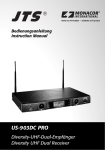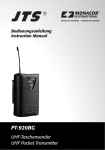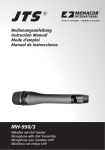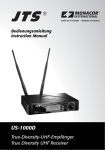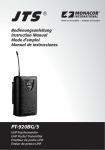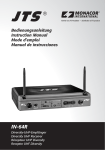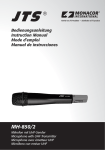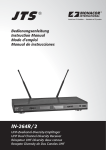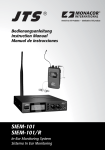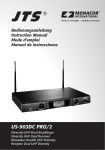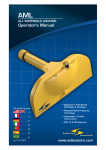Download MH-8990 - Monacor
Transcript
® Vertrieb von JTS-Produkten — Distribution of JTS products Bedienungsanleitung Instruction Manual MH-8990 Mikrofon mit UHF-Sender Microphone with UHF Transmitter DEUTSCH Bevor Sie einschalten … Wir wünschen Ihnen viel Spaß mit Ihrem neuen Gerät von JTS. Bitte lesen Sie diese Bedienungsanleitung vor dem Betrieb gründlich durch. Nur so lernen Sie alle Funktionsmöglichkeiten kennen, vermeiden Fehlbedienungen und schützen sich und Ihr Gerät vor eventuellen Schäden durch unsachgemäßen Gebrauch. Heben Sie die Anleitung für ein späteres Nachlesen auf. ENGLISH Der deutsche Text beginnt auf der Seite 4. Before switching on … We wish you much pleasure with your new JTS unit. Please read these operating instructions carefully prior to operating the unit. Thus, you will get to know all functions of the unit, operating errors will be prevented, and yourself and the unit will be protected against any damage caused by improper use. Please keep the operating instructions for later use. The English text starts on page 8. 2 1 12 ➁ MHz SET Mh-8990 2 3 4 5 6 ➂ 12 7 8 F OF OF F 3 POWE R E MUT 9 10 11 ➀ DEUTSCH Bitte klappen Sie die Seite 3 heraus. Sie sehen dann immer die beschriebenen Bedienelemente. 1 Übersicht der Bedienelemente 1 Mikrofonkapsel 2 Anzeige des Batteriestatus 3 Anzeige der Sendefrequenz oder der Sendegruppe und des Übertragungskanals (Abb. 4) Nach dem Einschalten des Mikrofons und beim Betätigen der Tasten (4 – 6) leuchtet die DisplayHintergrundbeleuchtung auf. Sie erlischt automatisch ca. 10 s nach dem letzten Tastendruck. 4 Taste zur Abwärtssuche für Sendegruppe/ Kanal (im Gruppen-/Kanaleinstellmodus), zum Verringern der Frequenz (im Frequenzeinstellmodus) bzw. der Empfindlichkeit (im Empfindlichkeitseinstellmodus) und zum Deaktivieren der Sperrfunktion (im Sperreinstellmodus) 5 Taste zur Aufwärtssuche für Sendegruppe/ Kanal (im Gruppen-/Kanaleinstellmodus), zum Erhöhen der Frequenz (im Frequenzeinstellmodus) bzw. der Empfindlichkeit (im Empfindlichkeitseinstellmodus) und zum Aktivieren der Sperrfunktion (im Sperreinstellmodus) 6 Taste SET bei nicht gesperrtem Mikrofon: zum Aufrufen und Verlassen der Einstellmodi für Sendegruppe/Kanal, Frequenz, Empfindlichkeit, Sperrfunktion → Kap. 5.1, 5.2, 5.3 und 5.4.1 bei gesperrtem Mikrofon: zum Aufrufen und Verlassen des Einstellmodus für die Sperrfunktion → Kap. 5.4.2 7 Kappe für das Batteriefach; zum Einsetzen oder Wechseln der Batterien (2 x 1,5-V-Mignon-Batterie) die Kappe abschrauben 8 Kennzeichnungsring; lässt sich gegen einen der beiliegenden Farbringe austauschen 9 Ein-/Ausschalter 10 Sicherungskappe zum Abdecken des Schalters, der gegen unbeabsichtigtes Verstellen geschützt werden soll 11 Mute-Schalter zur kurzen, störungsfreien Unterbrechung („Räusper-“ bzw. „Rückfrage-Modus“) und anschließender sofortiger Betriebsbereitschaft ohne Zeitverzögerung 12 4-poliger Steckkontakt, jeweils an der Mikrofonkapsel (Abb. 2) und am Handteil (Abb. 3); vor dem Zusammenschrauben von Mikrofonkapsel und Handteil die Kontakte ineinanderstecken 4 2 Wichtige Hinweise für den Gebrauch Das Mikrofon entspricht allen erforderlichen Richtlinien der EU und ist deshalb mit gekennzeichnet. ● Das Mikrofon ist nur zur Verwendung im Innenbereich geeignet. Schützen Sie es vor Tropf- und Spritzwasser, hoher Luftfeuchtigkeit und Hitze (zulässiger Einsatztemperaturbereich 0 – 40 °C). ● Verwenden Sie für die Reinigung nur ein trockenes, weiches Tuch, niemals Chemikalien oder Wasser. ● Wird das Mikrofon zweckentfremdet, falsch bedient oder nicht fachgerecht repariert, kann keine Haftung für daraus resultierende Sach- oder Personenschäden und keine Garantie für das Mikrofon übernommen werden. Soll das Mikrofon endgültig aus dem Betrieb genommen werden, übergeben Sie es zur umweltgerechten Entsorgung einem örtlichen Recyclingbetrieb. Werfen Sie verbrauchte Batterien bzw. defekte Akkus nicht in den Hausmüll, sondern geben Sie sie nur in den Sondermüll (z. B. Sammelbehälter bei Ihrem Einzelhändler). 3 Einsatzmöglichkeiten Dieses dynamische Handmikrofon mit integriertem Multifrequenz-Sender bildet mit dem MultifrequenzEmpfänger US-1000D von JTS ein drahtloses AudioÜbertragungssystem. Zum Einstellen der Sendefrequenz stehen zwei Modi zur Verfügung, um höchste Flexibilität zu gewährleisten: 1. Im Gruppenmodus arbeitet das Funkmikrofon mit vier Sendegruppen (A – D), denen jeweils 16 Übertragungskanäle zugeordnet sind. Insgesamt stehen also 64 werkseitig eingestellte Übertragungskanäle zur Verfügung. Diese Kanäle im UHF-Bereich von 790 – 814 MHz können frei ausgewählt werden. 2. Im Frequenzmodus lässt sich die Sendefrequenz innerhalb des UHF-Bereichs 790 – 814 MHz frei auswählen (Frequenzraster 25 kHz). Zum Lieferumfang gehören ein Mikrofonkoffer, ein Mikrofonhalter und farbige aufsteckbare Kunststoffringe zur Kennzeichnung des Mikrofons. 3.1 Konformität und Zulassung des Funkmikrofons Das Funkmikrofon ist nach den einschlägigen Normen der R + TTE-Richtlinie geprüft. Die Konformitätserklärung kann im Internet auf der Homepage von JTS abgerufen werden: www.jts-germany.de Der Frequenzbereich 790 – 814 MHz ist in Deutschland allgemein zugeteilt, die Allgemeinzuteilung einzelner Frequenzen des Bereichs ist jedoch an die Art der Nutzung gebunden. Das Funkmikrofon ist dementsprechend anmelde- und gebührenfrei, sofern bei der Wahl der Sendefrequenz die Vorgaben der Verfügung 91/2005 beachtet werden. Sie finden die Verfü- 4 Stromversorgung Setzen Sie nur Batterien des gleichen Typs ein und tauschen Sie die Batterien immer komplett aus. ● Nehmen Sie bei längerem Nichtgebrauch (z. B. länger als eine Woche) die Batterien heraus. So bleibt das Mikrofon bei einem eventuellen Auslaufen der Batterien unbeschädigt. 1) Die Kappe (7) für das Batteriefach abschrauben. 2) Zwei 1,5-V-Batterien der Größe Mignon (R6, AA), mit den Plus- und Minuspolen wie auf dem Halter aufgedruckt, einsetzen. 3) Die Batteriefachkappe gerade an das Gewinde des Mikrofonkörpers ansetzen und festschrauben. ● 5 Inbetriebnahme 1) Das Mikrofon noch ausgeschaltet lassen. Zuerst den Empfänger auf einen störungsfreien Übertragungskanal einstellen, siehe Bedienungsanleitung des Empfängers. 2) Danach das Mikrofon einschalten: Den Ein-/Ausschalter (9) unten am Mikrofon in die Position POWER stellen. Gegebenenfalls vorher die Sicherungskappe (10) nach unten schieben. Im Display (3) erscheint die eingestellte Sendegruppe mit entsprechendem Übertragungskanal (im Gruppenmodus), z. B. oder die Sendefrequenz (im Frequenzmodus) sowie ein Batteriesymbol (2), das den aktuellen Ladezustand der Batterien in mehreren Stufen anzeigt: voll 3) 4) 5) 6) erschöpft Sind die Batterien verbraucht (Anzeige ), wechselt zusätzlich zur Warnung am Empfänger die Displayfarbe von Grün auf Orange. Die leicht versenkten Tasten (4 – 6) lassen sich ohne weitere Hilfsmittel mit der Daumenspitze einfach betätigen. Das Mikrofon auf die gleiche Sendegruppe und den gleichen Übertragungskanal oder auf die gleiche Funkfrequenz wie am Empfänger einstellen: → Kapitel 5.1 bzw. Kapitel 5.2. In das Mikrofon sprechen bzw. singen. Der MuteSchalter (11) muss in der Position OFF stehen, anderenfalls wird kein Audiosignal übertragen. Durch Verändern der Empfindlichkeit lässt sich der Lautstärkepegel des Mikrofons korrigieren → Kap. 5.3. Das Mikrofon kann gesperrt werden, um ein versehentliches Verändern der Einstellungen oder um ein Ausschalten zu verhindern → Kap. 5.4. 7) Die Signalübertragung lässt sich für kurze Unterbrechungen störungsfrei stumm schalten → Kap. 5.5. 8) Der Kennzeichnungsring (8) kann auch gegen einen der beiliegenden farbigen Ringe ausgetauscht werden. Mehrere Systeme mit unterschiedlichen Funkfrequenzen lassen sich so farblich codieren. DEUTSCH gung im Internet auf der Homepage der Bundesnetzagentur: www.bundesnetzagentur.de Da für Funksysteme, die in diesem Frequenzbereich arbeiten, in anderen Ländern eventuell andere gesetzliche Bestimmungen gelten, informieren Sie sich vor der Inbetriebnahme des Systems außerhalb Deutschlands bitte bei der MONACOR-Niederlassung oder der entsprechenden Behörde des Landes. 9) Zum Ausschalten des Mikrofons nach dem Betrieb den Ein-/Ausschalter (9) auf OFF stellen. 5.1 Einstellen der Sendegruppe und des Übertragungskanals 1) Die Taste SET (6) 2 s gedrückt halten, bis im Display entweder die Anzeige „MHz“ blinkt oder die Gruppenanzeige , , oder . Blinkt die Anzeige „MHz“, die Taste SET noch einmal kurz betätigen, um in den Gruppeneinstellmodus zu gelangen. Hinweis: Um den Einstellmodus ohne eine Einstellung zu verlassen, die Taste SET so oft drücken, bis im Display erscheint. Das Mikrofon schaltet danach auf normalen Betrieb zurück. 2) Mit den Pfeiltasten die Sendegruppe einstellen: mit der Taste (4) werden die Gruppen absteigend durchlaufen, mit der Taste (5) aufsteigend. Die zugehörigen Kanäle und Sendefrequenzen sind in der Tabelle Abb. 4 angegeben. 3) Durch erneutes Drücken der Taste SET den Kanaleinstellmodus aufrufen. Im Display blinkt die Kanalanzeige 1 – 16. 4) Mit den Pfeiltasten den Übertragungskanal einstellen: mit der Taste werden die Kanäle absteigend durchlaufen, mit der Taste aufsteigend. 5) Die Einstellung durch Drücken der Taste SET speichern. Im Display erscheint kurz , der Einstellmodus wird verlassen und das Mikrofon wechselt auf den Normalbetrieb. Gruppe Kanal 1 2 3 4 5 6 7 8 9 10 11 12 13 14 15 16 A B C D 790,875 792,625 794,250 795,625 797,125 798,875 801,125 802,250 803,625 805,250 805,750 808,625 809,125 810,000 813,250 813,750 790,750 791,375 793,125 794,000 795,250 796,250 796,875 798,000 798,875 800,250 803,250 804,000 805,625 806,750 808,250 813,750 791,125 791,750 792,625 793,750 794,500 796,125 796,875 798,250 799,000 800,875 804,500 805,875 806,625 807,750 808,375 813,750 790,625 791,125 791,875 793,625 795,875 797,125 797,875 799,125 800,875 801,375 802,875 803,375 804,125 806,250 807,625 813,625 Abb. 4 Sendefrequenzen in MHz der Gruppen und Kanäle ® 5 DEUTSCH 5.2 Einstellen der Sendefrequenz 5.4 Mikrofon sperren/entsperren 1) Die Taste SET (6) 2 s gedrückt halten, bis im Display entweder die Anzeige „MHz“ blinkt oder die Gruppenanzeige , , oder . Blinkt die Gruppenanzeige, die Taste SET noch zweimal kurz betätigen, um in den Frequenzeinstellmodus zu gelangen. Hinweis: Um den Einstellmodus ohne eine Einstellung zu verlassen, die Taste SET so oft drücken, bis im Display erscheint. Das Mikrofon schaltet danach auf normalen Betrieb zurück. 2) Mit den Pfeiltasten die Frequenz einstellen: bei jedem Drücken der Taste (4) verringert sie sich um 25 kHz, bei jedem Drücken der Taste (5) erhöht sie sich um 25 kHz. Zum Durchlaufen eines großen Frequenzbereiches die entsprechende Taste gedrückt halten. Hinweis: Bei gleichzeitiger Verwendung mehrerer Funksysteme sollten die Funkfrequenzen der einzelnen Systeme sorgfältig aufeinander abgestimmt werden, um Störungen zu vermeiden. Frequenzbeispiele für den gleichzeitigen Betrieb mehrerer Systeme finden Sie im Internet auf www.jts-germany.de unter „Informationen/Intermodulationsfreies Frequenzsetup“. 3) Die Einstellung durch Drücken der Taste SET speichern. Im Display erscheint kurz , der Einstellmodus wird verlassen und das Mikrofon wechselt auf den Normalbetrieb. Bei gesperrtem Mikrofon ist es nicht möglich, a das Mikrofon auszuschalten; wird bei gesperrtem Mikrofon der Ein-/Ausschalter (9) auf OFF gestellt, zeigt das Display . b die Einstellmodi für Gruppe/Kanal, Frequenz und Empfindlichkeit aufzurufen. 5.3 Einstellen der Empfindlichkeit Die Mute-Funktion dient zur kurzen, störungsfreien Unterbrechung der Signalübertragung („Räusper-“ bzw. „Rückfrage-Modus“) und anschließender sofortiger Betriebsbereitschaft ohne Zeitverzögerung. 1) Den Schalter MUTE (11) unten am Mikrofon in die Position MUTE stellen. Gegebenenfalls vorher die Sicherungskappe (10) nach oben schieben. 2) Zum Fortfahren der Signalübertragung den Schalter MUTE in die Position OFF stellen. Hinweis: In der Schalterposition MUTE wird keine Sprache übertragen; das Mikrofon befindet sich aber weiterhin im Sendemodus und verbraucht Energie. Bei längeren Unterbrechungen daher unbedingt das Mikrofon mit dem Ein-/Ausschalter (9) abschalten (Position OFF). 1) Die Taste SET (6) 2 s gedrückt halten, danach die Taste SET noch dreimal kurz drücken, sodass das Display die aktuelle Empfindlichkeit anzeigt (0 dB, -6 dB, -12 dB oder -24 dB). Hinweis: Um den Einstellmodus ohne eine Einstellung zu verlassen, die Taste SET so oft drücken, bis im Display erscheint. Das Mikrofon schaltet danach auf normalen Betrieb zurück. 2) Die Empfindlichkeit nach der Anzeige AF im Display des Empfängers so einstellen, dass ein optimaler Lautstärkepegel des Mikrofons erreicht wird. Bei zu hoher Lautstärke verzerrt das Mikrofon, dann mit der Taste (4) einen niedrigeren Wert einstellen. Bei zu geringer Lautstärke ergibt sich ein schlechter Rauschabstand, dann mit der Taste (5) einen höheren Wert einstellen. 3) Die Einstellung durch Drücken der Taste SET speichern. Im Display erscheint kurz , der Einstellmodus wird verlassen und das Mikrofon wechselt auf den Normalbetrieb. 6 5.4.1 Sperrfunktion aktivieren 1) Die Taste SET (6) 2 s gedrückt halten, danach die Taste SET noch viermal kurz drücken, sodass im Display blinkt (Sperrung deaktiviert). 2) Die Taste (5) drücken: Im Display blinkt . 3) Die Einstellung durch Drücken der Taste SET speichern. Im Display erscheint kurz , der Einstellmodus wird verlassen und das Mikrofon wechselt auf den Normalbetrieb. 5.4.2 Sperrfunktion deaktivieren 1) Der Ein-/Ausschalter (9) muss auf POWER stehen. 2) Die Taste SET (6) 3 s gedrückt halten, bis im Display blinkt. 3) Die Taste (4) drücken: Im Display blinkt . 4) Die Einstellung durch Drücken der Taste SET speichern. Im Display erscheint kurz , der Einstellmodus wird verlassen und das Mikrofon wechselt auf den Normalbetrieb. 5.5 Mute-Funktion Austausch-Mikrofonkapsel Die Mikrofonkapsel (1) lässt sich gegen die Kondensator-Mikrofonkapsel DMC-8000-6 von JTS austauschen. Diese hat eine Supernieren-Richtcharakteristik und einen größeren Frequenzbereich (50 – 18 000 Hz). 1) Die Mikrofonkapsel (1) abschrauben. 2) Die Austausch-Mikrofonkapsel so auf das Handteil setzen, dass die 4-poligen Steckkontakte (12) von Kapsel und Handteil ineinanderfassen, dann die Kapsel auf das Handteil schrauben. 7 Technische Daten Gerätetyp: . . . . . . . . . dynamisches Handmikrofon mit PLL-Multifrequenz-Sender Richtcharakteristik: . . Hyperniere Funkfrequenzbereich: 790 – 814 MHz DEUTSCH 6 Audiofrequenzbereich: 50 – 16 000 Hz Frequenzstabilität: . . . ±0,005 % Sendeleistung:. . . . . . 10 mW (EIRP) Einsatztemperatur: . . 0 – 40 °C Stromversorgung: . . . zwei 1,5-V-Batterien der Größe Mignon (R6, AA) Abmessungen:. . . . . . Ø 53 mm x 245 mm Gewicht:. . . . . . . . . . . 360 g Änderungen vorbehalten. Diese Bedienungsanleitung ist urheberrechtlich für MONACOR ® INTERNATIONAL GmbH & Co. KG geschützt. Eine Reproduktion für eigene kommerzielle Zwecke – auch auszugsweise – ist untersagt. ® 7 ENGLISH Please unfold page 3. Then you can always see the operating elements described. 1 Operating Elements 1 Microphone cartridge 2 Battery status indication 3 Indication of the transmission frequency or the transmission group and the transmission channel (fig. 4) After switching on the microphone and when actuating the keys (4 – 6), the display background illumination will light up. It will automatically be extinguished approx. 10 s after the last actuation of a key. 4 Key for scanning the transmission group/channel in descending order (in the group adjusting mode/channel adjusting mode), for decreasing the frequency (in the frequency adjusting mode) or the sensitivity (in the sensitivity adjusting mode), and for deactivating the locking function (in the lock adjusting mode) 5 Key for scanning the transmission group/channel in ascending order (in the group adjusting mode/channel adjusting mode), for increasing the frequency (in the frequency adjusting mode) or the sensitivity (in the sensitivity adjusting mode), and for activating the locking function (in the lock adjusting mode) 6 Key SET with the microphone not locked: to call and exit the adjusting modes for transmission group/channel, frequency, sensitivity, locking function → chapters 5.1, 5.2, 5.3, and 5.4.1 with the microphone locked: to call and exit the adjusting mode for the locking function → chapter 5.4.2 7 Cap for the battery compartment; to insert or replace the batteries (2 x 1.5 V batteries of size AA), unscrew the cap 8 Identification ring; can be replaced by one of the colour-coded rings supplied 9 Power switch 10 Safety cap for covering the switch to be protected against accidental readjustment 11 Mute switch for short muting (“throat clearing mode” or “enquiry mode”) with subsequent immediate readiness for operation without delay 12 4-pole contact, each on the microphone cartridge (fig. 2) and on the handle (fig. 3); prior to assembling the microphone cartridge and the handle, fit the contacts into each other 8 2 Important Notes The microphone corresponds to all required directives of the EU and is therefore marked with . ● The microphone is suitable for indoor use only. Protect it against dripping water and splash water, high air humidity, and heat (admissible ambient temperature range 0 – 40 °C). ● For cleaning only use a dry, soft cloth; never use chemicals or water. ● No guarantee claims for the microphone and no liability for any resulting personal damage or material damage will be accepted if the microphone is used for other purposes than originally intended, if it is not correctly operated or not repaired in an expert way. If the microphone is to be put out of operation definitively, take it to a local recycling plant for a disposal which is not harmful to the environment. Dead batteries or defective rechargeable batteries do not belong in the household rubbish; always take them to a special waste disposal (e. g. collecting container at your retailer). 3 Applications Together with the multifrequency receiver US-1000D from JTS, this dynamic hand-held microphone with integrated multifrequency transmitter makes up a wireless audio transmission system. For adjusting the transmission frequency, two modes are available to ensure maximum flexibility: 1. In the group mode, the wireless microphone operates with four transmission groups (A – D) to which 16 transmission channels are assigned respectively, i. e. altogether 64 factory-set transmission channels are available. These channels in the UHF range of 790 – 814 MHz can be selected as desired. 2. In the frequency mode, the transmission frequency within the UHF range of 790 – 814 MHz can be selected as desired (frequency spacing 25 kHz). The microphone is supplied with a microphone case, a microphone holder, and coloured push-on plastic rings for identification of the microphone. 3.1 Conformity and approval of the wireless microphone The wireless microphone has been tested according to the relevant standards of the R + TTE directive. The declaration of conformity can be found in the Internet on the JTS home page (www.jts-germany.de). In the Federal Republic of Germany, the frequency range of 790 – 814 MHz is generally assigned, however, the general assignment of individual frequencies of the range is subject to the type of use [see the directive 91/2005 on the home page of the Bundesnetzagentur (Federal Network Agency): www.bundesnetzagentur.de]. 8) The identification ring (8) can be exchanged against one of the coloured rings supplied. This allows colour coding of several systems with different radio frequencies. 9) To switch off the microphone after operation, set the POWER switch (9) to OFF. 4 5.1 Adjusting the transmission group and the transmission channel Power Supply Only insert batteries of the same type and always replace all batteries. ● If the microphone is not used for a longer period (e. g. more than a week), remove the batteries. Thus, the microphone will not be damaged in case of battery leakage. 1) Unscrew the cap (7) for the battery compartment. 2) Insert two 1.5 V batteries of size AA (R6) with the positive and negative connections as indicated on the holder. 3) Place the battery compartment cap straight against the thread of the microphone body and screw it on. ● 5 Setting the Microphone into Operation 1) Before switching on the microphone, set the receiver to an interference-free transmission channel (see instruction manual of the receiver). 2) Then switch on the microphone: Set the POWER switch (9) at the lower end of the microphone to the position POWER. If required, slide the safety cap (10) downwards beforehand. The display (3) will indicate the transmission group adjusted with the corresponding transmission channel (in the group mode), e. g. or the transmission frequency (in the frequency mode) and a battery symbol (2) showing the current charging status of the batteries in several steps: fully charged 3) 4) 5) 6) 7) 1) Keep the key SET (6) pressed for 2 s until either the indication “MHz” or the group indication , , or starts flashing on the display. If the indication “MHz” starts flashing, shortly actuate the key SET once again to go to the group adjusting mode. Note: To exit the adjusting mode without making an adjustment, press the key SET so many times until the display shows . The microphone will then return to normal operation. 2) Use the cursor keys to adjust the transmission group: With the key (4), the groups will be scanned in descending order; with the key (5), they will be scanned in ascending order. The corresponding channels and transmission frequencies can be found in the table in fig. 4. 3) Press the key SET again to call the channel adjusting mode. On the display, the channel indication 1 – 16 will start flashing. 4) Use the cursor keys to adjust the transmission channel: With the key , the channels will be scanned in descending order; with the key , they will be scanned in ascending order. 5) To memorize the adjustment, press the key SET. The display will shortly show , the adjusting mode will be exited, and the microphone will go to normal operation. Group exhausted If the batteries are exhausted (indication ), the colour of the display on the receiver will additionally change from green to orange as a warning. The keys (4 – 6) which are slightly recessed are easily actuated by means of the tip of your thumb. Set the microphone to the same transmission group and the same transmission channel or the same radio frequency adjusted on the receiver: → chapter 5.1 or chapter 5.2 Speak/sing into the microphone. The mute switch (11) must be in the position OFF, otherwise no audio signal will be transmitted. The volume level of the microphone can be readjusted by modification of the sensitivity → chapter 5.3. The microphone can be locked to prevent accidental modification of the adjustments or switching off: → chapter 5.4. For short interruptions, the signal transmission can be muted so that no interference will occur → chapter 5.5. ENGLISH In other countries, different legal regulations may apply for wireless systems operating in this frequency range. Therefore, please contact the MONACOR subsidiary or the corresponding authorities of the country prior to setting the system into operation outside Germany. A B C D 790.875 792.625 794.250 795.625 797.125 798.875 801.125 802.250 803.625 805.250 805.750 808.625 809.125 810.000 813.250 813.750 790.750 791.375 793.125 794.000 795.250 796.250 796.875 798.000 798.875 800.250 803.250 804.000 805.625 806.750 808.250 813.750 791.125 791.750 792.625 793.750 794.500 796.125 796.875 798.250 799.000 800.875 804.500 805.875 806.625 807.750 808.375 813.750 790.625 791.125 791.875 793.625 795.875 797.125 797.875 799.125 800.875 801.375 802.875 803.375 804.125 806.250 807.625 813.625 Channel 1 2 3 4 5 6 7 8 9 10 11 12 13 14 15 16 Fig. 4 Transmission frequencies in MHz of the groups and channels ® 9 ENGLISH 5.2 Adjusting the transmission frequency 5.4 Locking/Unlocking the microphone 1) Keep the key SET (6) pressed for 2 s until either the indication “MHz” or the group indication , , or starts flashing on the display. If the group indication starts flashing, shortly actuate the key SET twice again to go to the frequency adjusting mode. Note: To exit the adjusting mode without making an adjustment, press the key SET so many times until the display shows . The microphone will then return to normal operation. 2) Use the cursor keys to adjust the frequency: Each time the key (4) is pressed, the frequency will be decreased by 25 kHz; each time the key (5) is pressed, it will be increased by 25 kHz. To scan a wide frequency range, keep the corresponding key pressed. Note: If several wireless transmission systems are operated at the same time, the radio frequencies of the individual systems should be carefully matched to each other to prevent interference. Examples for frequencies for simultaneous operation of several systems can be found in the Internet on www.jts-germany.de under “Informationen/Intermodulationsfreies Frequenzsetup”. 3) To memorize the adjustment, press the key SET. The display will shortly indicate , the adjusting mode will be exited and the microphone will go to normal operation. With the microphone locked, it is not possible 5.3 Adjusting the sensitivity 1) Keep the key SET (6) pressed for 2 s, then shortly press the key SET another three times so that the display will indicate the current sensitivity (0 dB, -6 dB, -12 dB, or -24 dB). Note: To exit the adjusting mode without making an adjustment, press the key SET so many times until the display shows . The microphone will then return to normal operation. 2) Adjust the sensitivity according to the indication AF on the display of the receiver in such a way to obtain an optimum volume level of the microphone. If the volume is too high, the microphone will distort; in this case, adjust a lower value with the key (4). If the volume is too low, there will be a poor signalnoise ratio; in this case, adjust a higher value with the key (5). 3) To memorize the adjustment, press the key SET. The display will shortly indicate , the adjusting mode will be exited and the microphone will go to normal operation. 10 a to switch off the microphone; if the POWER switch (9) is set to OFF with the microphone locked, the display will show . b to call the adjusting modes for group/channel, frequency, and sensitivity. 5.4.1 Activating the locking function 1) Keep the key SET (6) pressed for 2 s, then shortly press the key SET another four times so that the indication (lock deactivated) starts flashing on the display. 2) Press the key display. (5): starts flashing on the 3) To memorize the adjustment, press the key SET. The display will shortly indicate , the adjusting mode will be exited and the microphone will go to normal operation. 5.4.2 Deactivating the locking function 1) The POWER switch (9) must be set to POWER. 2) Keep the key SET (6) pressed for 3 s until starts flashing on the display. 3) Press the key display. (4): starts flashing on the 4) To memorize the adjustment, press the key SET. The display will shortly indicate , the adjusting mode will be exited and the microphone will go to normal operation. 5.5 Mute function The mute function serves for short muting of the signal transmission (“throat clearing mode” or “enquiry mode”) with subsequent immediate readiness for operation without delay. 1) Set the MUTE switch (11) at the lower end of the microphone to the position MUTE. If required, slide the safety cap (10) upwards beforehand. 2) To continue the signal transmission, set the MUTE switch to the position OFF. Note: In the switch position MUTE, there will be no speech transmission; however, the microphone will still be in the transmission mode and consume power. Therefore, always switch off the microphone with the POWER switch (9) [position OFF] for longer interruptions. Replacement Microphone Cartridge The microphone cartridge (1) can be replaced by the capacitor microphone cartridge DMC-8000-6 by JTS which offers a supercardioid characteristic and a wider frequency range (50 – 18 000 Hz). 1) Unscrew the microphone cartridge (1). 2) Place the replacement microphone cartridge on the handle in such a way that the 4-pole contacts (12) of the cartridge and of the handle fit into each other, then screw the cartridge on the handle. 7 Specifications Type of unit: . . . . . . . . dynamic hand-held microphone with PLL multifrequency transmitter Directivity: . . . . . . . . . hypercardioid ENGLISH 6 Radio frequency range: . . . . . . . . . . . . 790 – 814 MHz Audio frequency range: . . . . . . . . . . . . 50 – 16 000 Hz Frequency stability: . . ±0.005 % Transmitting power: . . 10 mW (EIRP) Ambient temperature: 0 – 40 °C Power supply: . . . . . . two 1.5 V batteries of size AA (R6) Dimensions: . . . . . . . Ø 53 mm x 245 mm Weight: . . . . . . . . . . . 360 g Subject to technical modification. All rights reserved by MONACOR ® INTERNATIONAL GmbH & Co. KG. No part of this instruction manual may be reproduced in any form or by any means for any commercial use. ® 11 www.jts-germany.de Copyright © by MONACOR INTERNATIONAL GmbH & Co. KG, Bremen, Germany. All rights reserved. A-0627.99.01.06.2006














